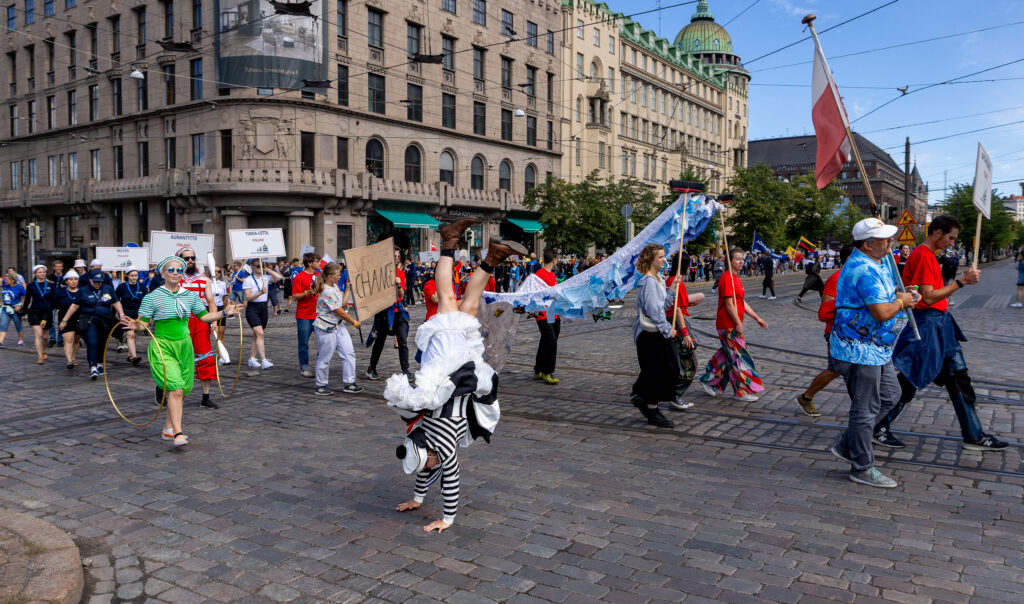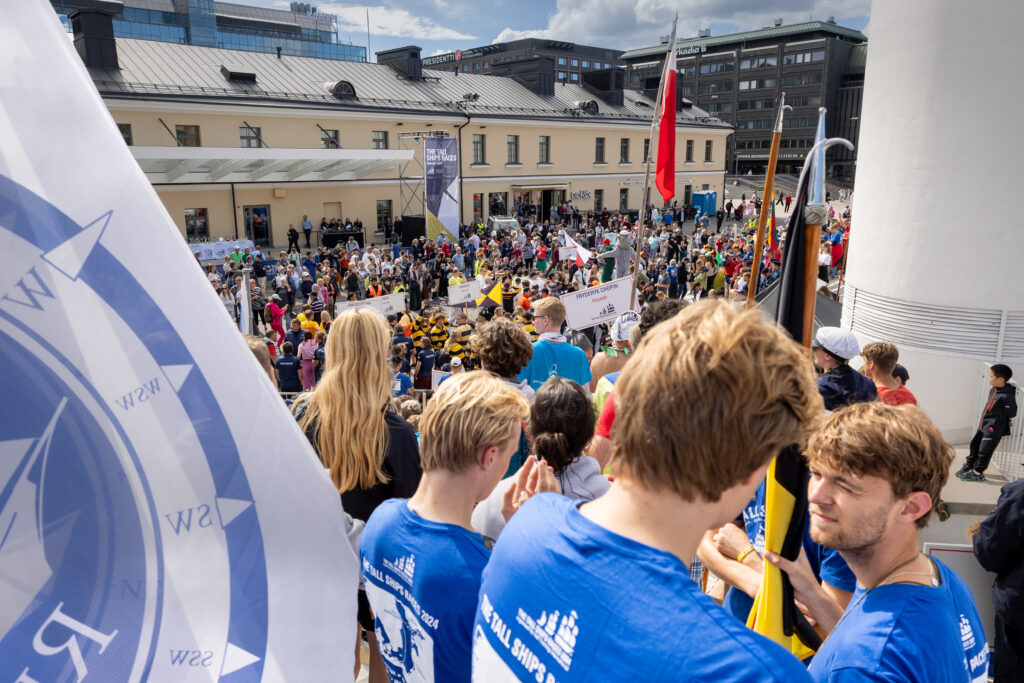The joyful crew parade went through the Helsinki

A thousand-strong crew from the sailing ships will fill Helsinki’s Senate Square on Friday afternoon. From the ships moored at the South Harbor and North Harbor piers, cheerful and expressive crowds will flood the square, some wrapped in sauna towels, others in black official crew uniforms with white peaked caps gleaming in the afternoon sun. Music blares, grinders sound, and shouts fill the air as the crews gather for a group photo on the cathedral steps before the parade.
The Tall Ships Races are always particularly a celebration for the youth. Most TSR young sailors are between 15-25 years old. One of the highlights of the sailing event is the grand crew parade, held in each port city. The parade is also a joyous spectacle for the city’s residents watching, as the young sailors know how to have fun and make noise – all sorts of noise! This time, more than a thousand sailors from thirteen countries and fifty ships that came to Helsinki participated in the crew parade from Senate Square to Lasipalatsi Square.

The ship from the farthest country, the barque named Guayas, has sailed to Helsinki from Ecuador. While the Danish crews of Betty and Tara make the most noise, Guayas’s crew of over one hundred and fifty performs professionally in their black uniforms, caps in order and gold buttons shining. In this group, dancing is left to characters dressed as colorful demons. With the same restrained charm, the Ecuadorians are the last crew to move to the cathedral steps.
The Danish women Nina Jensen and Catrine Larsen are crew members of the schooner Betty. Amidst forming the parade formation, they manage to answer a few questions, as much as they can amidst the commotion from the rest of the crew. The journey from Klaipeda, Lithuania to Helsinki took Betty three days; a storm tested them, but the sailing went well. Both have several years of sailing experience, but this is Nina’s first time participating in the TSR.
“Being at sea takes your mind off other things; you don’t have to worry about everyday matters. Everyone works equally on the ship, taking on different tasks, with four hours on duty and four hours of rest,” Nina and Catrine explain about life on board.
For both of them, Helsinki, and northern Europe in general, is an unfamiliar region. Neither of the young women has visited any Eastern European country, nor Helsinki, nor even Stockholm before.
“Helsinki is beautiful, and everything in this event is very well organized!” Nina and Catrine praise.

The crew parade progresses from Senate Square as a vibrant and joyful procession along Aleksanterinkatu and Mannerheimintie to Lasipalatsi Square. The crew of the Polish ship Fryderyk Chopin dances the entire way, wrapped in sauna towels, to the music booming from massive speakers, putting on perhaps the biggest show together with their colleagues from Dar Mlodziezy and Pogoria. The sailors from the Finnish vessels have a somewhat more reserved demeanor, but the joy unites the crews of ships from all countries.
At Lasipalatsi Square, the parade culminates in an awards ceremony. The most anticipated awards are for the fastest ships on the Klaipeda-Helsinki leg, with the top three in each size category receiving trophies. In the D-class, the top three are: 1st place Dar Szczenina from Poland, 2nd place Linda from Estonia, and 3rd place Theia from Finland. For the C-class, the top three are: 1st place Helena from Finland, 2nd place Belfer from Poland, and 3rd place Esprit from Germany. In the B-class, the top three are: 1st place Albanus from Finland, 2nd place Brabander from Estonia, and 3rd place Constantia from Sweden. The largest class, A-class, sees the top three as follows: 1st place Fryderyk Chopin from Poland, 2nd place Dar Mlodziezy from Poland, and 3rd place Kapitan Glowacki from Poland.
